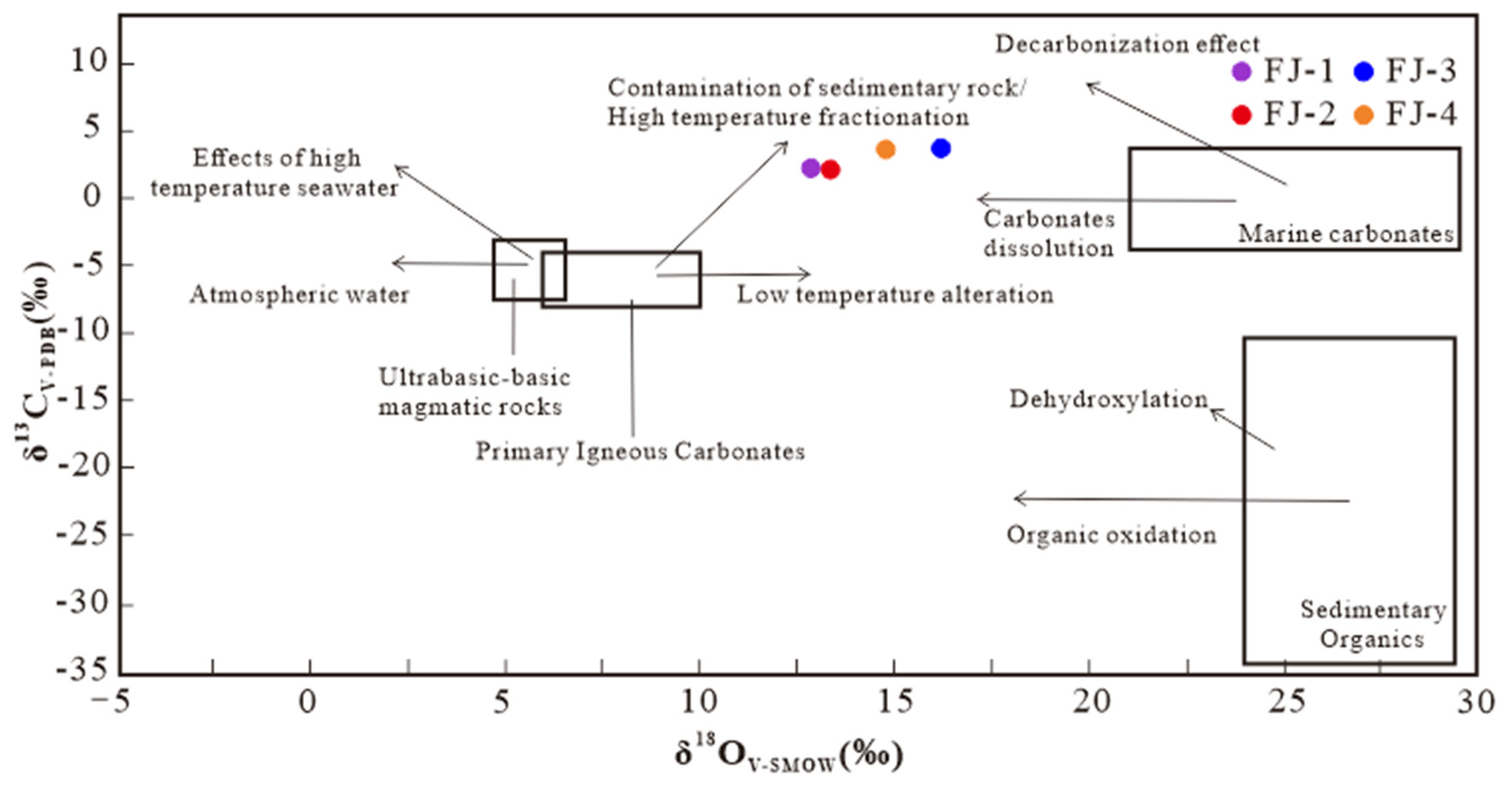Mineralogical Characteristics Study of Calcite from the Fujian Province, China
(This article belongs to the Section Mineralogical Crystallography and Biomineralization)
Abstract
1. Introduction
2. Geological Setting
3. Materials and Methods
4. Results
4.1. Visual Appearance and Mineralogical Properties
4.2. Spectral Characteristics
4.2.1. Fourier Transform Infrared Spectrum
4.2.2. Raman Spectrum
4.3. Phase Composition
4.4. Major Elements Characteristics
4.4.1. X-ray Fluorescence Spectrum (XRF)
4.4.2. Micro Area X-ray Fluorescence Spectrum (Micro-XRF)
4.5. C-O Isotope Characteristics
5. Discussion
5.1. Precipitation Mechanism of Fujian Calcites
5.2. Origin Characteristics of Fujian Calcite
6. Conclusions
Author Contributions
Funding
Data Availability Statement
Acknowledgments
Conflicts of Interest
Appendix A
| CaO/% | SiO2/% | K2O/% | Fe2O3/% | MnO/% | CuO/% | Br/% | SrO/% | ||
|---|---|---|---|---|---|---|---|---|---|
| FJ-1 | 1 | 98.64 | 0.79 | 0.08 | 0.06 | 0.01 | 0.01 | / | / |
| 2 | 93.28 | 0.68 | 0.07 | / | / | 0.01 | / | 0.03 | |
| 3 | 98.87 | 0.69 | / | 0.03 | 0.01 | / | 0.01 | 0.05 | |
| 4 | 98.53 | 0.76 | 0.07 | 0.05 | 0.01 | / | 0.01 | 0.06 | |
| 5 | 94.83 | 0.63 | 0.07 | 0.04 | / | / | / | 0.04 | |
| FJ-2 | 1 | 98.97 | 0.68 | 0.07 | 0.06 | 0.02 | 0.01 | / | 0.02 |
| 2 | 99.06 | 0.71 | 0.06 | 0.06 | 0.01 | 0.01 | / | 0.04 | |
| 3 | 92.55 | 0.71 | 0.09 | / | 0.02 | 0.01 | 0.01 | 0.03 | |
| 4 | 99.08 | 0.66 | 0.08 | / | 0.02 | 0.01 | 0.01 | 0.03 | |
| 5 | 98.80 | 0.70 | 0.07 | 0.04 | 0.02 | / | 0.01 | 0.03 | |
| FJ-3 | 1 | 91.25 | 0.66 | / | / | 0.01 | / | 0.01 | 0.06 |
| 2 | 98.86 | 0.67 | / | 0.01 | 0.02 | 0.01 | / | 0.06 | |
| 3 | 93.19 | 0.64 | / | / | 0.01 | / | 0.01 | 0.04 | |
| 4 | 98.61 | 0.75 | 0.06 | / | 0.01 | / | 0.01 | 0.05 | |
| 5 | 98.70 | 0.67 | 0.07 | 0.01 | 0.018 | 0.01 | / | 0.06 | |
| FJ-4 | 1 | 93.55 | 0.65 | / | / | 0.126 | / | / | 0.10 |
| 2 | 92.17 | 0.65 | 0.07 | / | 0.092 | / | / | 0.09 | |
| 3 | 91.94 | 0.67 | 0.07 | / | 0.093 | / | 0.01 | 0.10 | |
| 4 | 97.83 | 0.19 | 0.07 | 0.01 | 0.154 | 0.02 | / | 0.14 | |
| 5 | 98.67 | 0.70 | / | 0.01 | 0.119 | / | 0.01 | 0.12 |
| FJ-1 | FJ-2 | FJ-3 | FJ-4 | |
|---|---|---|---|---|
| Ca | 39.52 | 39.53 | 39.56 | 39.60 |
| C | 11.93 | 11.94 | 11.92 | 11.98 |
| O | 47.69 | 47.73 | 47.98 | 47.89 |
| Mg | 0.14 | 0.18 | 0.16 | 0.19 |
| Mn | 0.01 | 0.01 | 0.01 | 0.01 |
| Fe | 0.08 | 0.05 | 0.02 | 0.01 |
References
- Zhou, J.-X.; Huang, Z.-L.; Zhou, G.-F.; Zeng, Q.-S.C. O Isotope and REE Geochemistry of the Hydrothermal Calcites from the Tianqiao Pb-Zn Ore Deposit in NW Guizhou Province, China. Geotecton. Metallog. 2012, 36, 93–101. [Google Scholar]
- Huang, Z.-L.; Li, X.-B.; Zhou, M.; Li, W.-B.; Jin, Z.-G. REE and C-O Isotopic Geochemistry of Calcites from the World-class Huize Pb-Zn Deposits, Yunnan, China: Implications for the Ore Genesis. Acta Geol. Sin. 2010, 84, 597–613. [Google Scholar] [CrossRef]
- Hou, Z.-Q.; Tian, S.-H.; Xie, Y.-L.; Yuan, Z.-X.; Yang, Z.-S.; Yin, S.-P.; Fei, H.-C.; Zou, T.-R.; Li, X.-Y.; Yang, Z.-M. Mianning-Dechang Himalayan REE belt associated with carbonatite-alkalic complex in eastern Indo-Asian collision zonesouthwest China: Geological characteristics of REE deposits and a possible metallogenic model. Miner. Depos. 2008, 2, 145–176. [Google Scholar]
- Hou, Z.-Q.; Liu, Y.; Tian, S.-H.; Yang, Z.-M.; Xie, Y.-L. Formation of carbonatite-related giant rare-earth-element deposits by the recycling of marine sediments. Sci. Rep. 2015, 5, 10231. [Google Scholar] [CrossRef] [PubMed]
- Tang, B.-L.; Liu, Y.-C.; Yue, L.-L.; Ma, W.; Zhuang, L.-L. Hydrothermal fluid evolution in Huachangshan Pb-Zn deposit in Yunnan:the evidences of calcite REE and C-O isotope analyses. Acta Geol. Sin. 2022. [CrossRef]
- Tang, Y.-Y.; Bi, X.-W.; He, L.-P.; Wu, L.-Y.; Feng, C.-X.; Zou, Z.-C.; Tao, Y.; Hu, R.-Z. Geochemical characteristics of trace elementsfluid inclusions and carbon- oxygen isotopes of calcites in the Jinding Zn-Pb deposit, Lanping, China. Acta Petrol. Sin. 2011, 27, 2635–2645. [Google Scholar]
- Tang, G.-Q.; Li, X.-H.; Li, Q.; Liu, Y.; Ling, X.X. A new Chinese national reference material (GBW04481) for calcite oxygen and carbon isotopic microanalysis. Surf. Interface Anal. SIA 2020, 52, 190–196. [Google Scholar] [CrossRef]
- Hu, A.-X.; Wen, J.; Peng, J.-T. Rare earth elements’ geochemistry of calcites in the Xikuangshan antimony deposit, central Hunan and its indicative significance for prospecting. Acta Mineral. Sin. 2023, 43, 38–48. [Google Scholar] [CrossRef]
- Wang, H.; Zhong, F.-J.; Wu, D.-H.; Pan, J.-Y.; Shu, T.-T.; Yan, J.; Li, D.-H.; Zhang, R.; Liu, B. Characteristics and Geological Implications of Carbon and Oxygen Isotopes and REE of Calcite from Egongtang Deposit in Northern Guangdong Province. Chin. Rare Earths 2022. [Google Scholar] [CrossRef]
- Xing, Z.-J.; Leon, B.; Zhonghua, H.; Wengang, L. Sm-Nd isochron age and Sr-Nd isotopes of the calcitefrom the Nibao gold deposit in the Youjiang Basin, SW China. Resour. Geol. 2022, 72, e12292. [Google Scholar]
- Myint, A.Z.; Wagner, T.; Fusswinkel, T. Calcite trace element geochemistry of Au deposits in the Singu-Tabeikkyin Gold District, Myanmar: Implications for the sources of ore-forming fluids. Ore Geol. Rev. 2022, 145, 104692. [Google Scholar] [CrossRef]
- RRUFF Database. Available online: https://rruff.info/calcite/display=default/R040070 (accessed on 1 October 2022).
- Xu, B.; Hou, Z.Q.; Griffin, W.L.; Lu, Y.; Belousova, E.; Xu, J.F.; O’Reilly, S.Y. Recycled volatiles determine fertility of porphyry deposits in collisional settings. Am. Mineral. 2021, 106, 656–661. [Google Scholar] [CrossRef]
- Xu, B.; Kou, G.; Etschmann, B.; Liu, D.; Brugger, J. Spectroscopic, Raman, EMPA, Micro-XRF and Micro-XANES Analyses of Sulphur Concentration and Oxidation State of Natural Apatite Crystals. Crystals 2020, 10, 1032. [Google Scholar] [CrossRef]
- Xu, B.; Hou, Z.-Q.; Griffin, W.L.; O’Reilly, S.Y.; Zheng, Y.C.; Wang, T.; Xu, J.F. In-situ mineralogical interpretation of the mantle geophysical signature of the Gangdese Cu-porphyry mineral system. Gondwana Res. 2022, 111, 53–63. [Google Scholar] [CrossRef]
- Yang, N.; Kuang, S.-Y.; Yue, Y.-H. Infrared Spectra Analysis of Several Common Anhydrouscarbonate Minerals. Mineral. Petrol. 2015, 35, 37–42. [Google Scholar] [CrossRef]
- Zhu, Y.; Li, Y.-Z.; Lu, A.-H.; Ding, H.-D.; Li, Y.; Wang, C.-Q. Middle and far infrared spectroscopic analysis of calcite, dolomite and magnesite. Earth Sci. Front. 2022, 29, 459–469. [Google Scholar] [CrossRef]
- He, J.-L.; Pan, Z.-X.; Ran, J. The Application of Laser Raman Spectroscopy to Rock and Mineral Identification. Acta Geol. Sichuan 2016, 36, 346–349. [Google Scholar]
- Hu, Z.-Z.; Yan, X.; Du, G.; Wang, G.; Xu, G.-D.; He, J.-L.; Jin, L.; Lan, M.-G.; He, X.-H. The Calcite 811N, a potential isotope standard material for isotopic analyses of carbon, oxygen and strontium. Sediment. Geol. Tethyan Geol. 2022, 15, 1–24. [Google Scholar] [CrossRef]
- Friedman, I.; O’Nei, J.R. Compilation of stable isotope fractionation factors of geochemical interest. Data Geochem. 1977, 440, 1–55. [Google Scholar]
- Liu, J.-K.; Deng, M.-G.; Mao, L.-Z.; Wang, D.; Geng, Q.-W. Characteristics and Indication of Carbon-Oxygen lsotopes and Rare Earth Elements of Hydrothermal Calcite from the Mengxing Pb-Zn Deposit, Western Yunnan. Geol. Explor. 2021, 57, 852–864. [Google Scholar]
- Tian, S.-H.; Hou, Z.-Q.; Yang, Z.-S.; Chen, W.; Yang, Z.-M.; Yuan, Z.-X.; Xie, Y.-L.; Fei, H.-C.; Yin, S.-P.; Liu, Y.-C.; et al. Geochronology of REE deposits in Mianning-Dechang REE metallogenic belt:Constraints on duration of hydrothermal activities and tectonic mode for carbonatite-alkalic complexes in southwestern Sichuan. Miner. Depos. 2008, 27, 177–187. [Google Scholar]
- Zhu, Z.-M.; Zheng, R.-C.; Luo, L.-P.; Zhou, J.-Y.; Shen, B.; Chen, J.-B. Element Geochemistry and its genetic significant of calcite in the MuLuo REE deposit, SiChuan province. Acta Mineral. Sin. 2008, 28, 455–460. [Google Scholar]
- Wang, J.-S.; Han, Z.-C.; Li, C.; Gao, Z.-H.; Yang, Y.; Zhou, G.-C. REE, Fe and Mn Contents of Calcites and Their Prospecting Significance for the Banqi Carlin-type Gold Deposit in Southwestern China. Geotecton. Metallog. 2018, 42, 494–504. [Google Scholar]
- Zheng, Y.-F. Theoretical modeling of stable isotope systems and its applications to geochemistry of hydrothermal ore deposits. Miner. Depos. 2021, 20, 69–76. [Google Scholar]
- Chen, Q.; Gao, X.; Tan, S.; Huang, J. Geochemical characteristics and indicative significance of hydrothermal vein in the Xiangyangping uranium ore deposit, middle segment of Miao’er Mountain, northern Guangxi. Acta Petrol. Mineral. 2020, 39, 795–807. [Google Scholar]
- Xu, B.; Hou, Z.Q.; Griffin, W.L.; Zheng, Y.C.; Wang, T.; Guo, Z.; Hou, J.; Santosh, M.; O’Reilly, S.Y. Cenozoic lithospheric architecture and metallogenesis in Southeastern Tibet. Earth-Sci. Rev. 2021, 214, 103472. [Google Scholar] [CrossRef]
- Xu, B.; Griffin, W.L.; Xiong, Q.; Hou, Z.Q.; O’Reilly, S.Y.; Guo, Z.; Pearson, N.; Greau, Y.; Zheng, Y.C. Ultrapotassic rocks and xenoliths from South Tibet: Contrasting styles of interaction between lithospheric mantle and asthenosphere during continental collision. Geology 2017, 45, 51–54. [Google Scholar] [CrossRef]
- Xu, B.; Hou, Z.Q.; Griffin, W.L.; O’Reilly, S.Y. Apatite halogens and Sr–O and zircon Hf–O isotopes: Recycled volatiles in Jurassic porphyry ore systems in southern Tibet. Chem. Geol. 2022, 605, 120924. [Google Scholar] [CrossRef]
- Yang, C.-F.; Gu, X.-X.; Liu, J.-Z.; Wang, Z.-P.; Chen, F.-E.; Wang, D.-F.; Chen, L.-Y.; Li, J.-H. Rare Earth Elements and C-O-SrIsotopic Geochemical Characteristic of Hydrothermal Calcites of the Carlin-Type Gold Deposits in the Huijiabao Orefield, Southwestern Guizhou, China. Bull. Mineral. Petrol. Geochem. 2021, 40, 124–137. [Google Scholar] [CrossRef]
- Zheng, Y.-F.; Hoefs, J. Carbon and oxygen isotopic covariations in hydrothermal calcites. Miner. Depos. 1993, 28, 79–89. [Google Scholar] [CrossRef]
- Spangenberg, J.; Fontboté, L.; Sharp, Z.D.; Hunziker, J. Carbon and oxygen isotope study of hydrothermal carbonates in the zinc-lead deposits of the San Vicente district, central Peru: A quantitative modeling on mixing processes and CO2 degassing. Chem. Geol. 1996, 133, 289–315. [Google Scholar] [CrossRef]
- Wu, L.-Y.; Hu, R.-Z.; Peng, J.-T.; Bi, X.-W.; Chen, H.-W.; Wang, Q.-Y.; Liu, Y.-Y. Carbon and oxygen isotopic compositions o Chaishan Pb-Zn deposit in the Shizhuyuan ore field and implications. Geochimica 2009, 38, 242–250. [Google Scholar] [CrossRef]
- Li, R.-Q. Variation of Mg-Fe-Mn contents of calcite and its significance in Southern Hunan polymetallic province. Hunan Geol. 1995, 14, 99–105. [Google Scholar]
- Shuang, Y.; Bi, X.-W.; Hu, R.-Z.; Peng, J.-T.; Li, Z.-L.; Li, X.-M.; Yuan, S.-D.; Qi, Y.-Q. Ree Geochemistry Of Hydrothermal Calcite From Tin-Polymetallic Deposit And Its Indication Of Source Of Hydrothermal Ore-Forming Fluid. J. Mineral. Petrol. 2006, 26, 57–65. [Google Scholar]
- Crowley, S.F. Mineralogical and chemical composition of international carbon and oxygen isotope calibration material NBS19, and reference materials NBS18, IAEA-CO-1 and IAEA-CO-8. Geostand. Geoanalytical Res. 2010, 34, 193–206. [Google Scholar] [CrossRef]
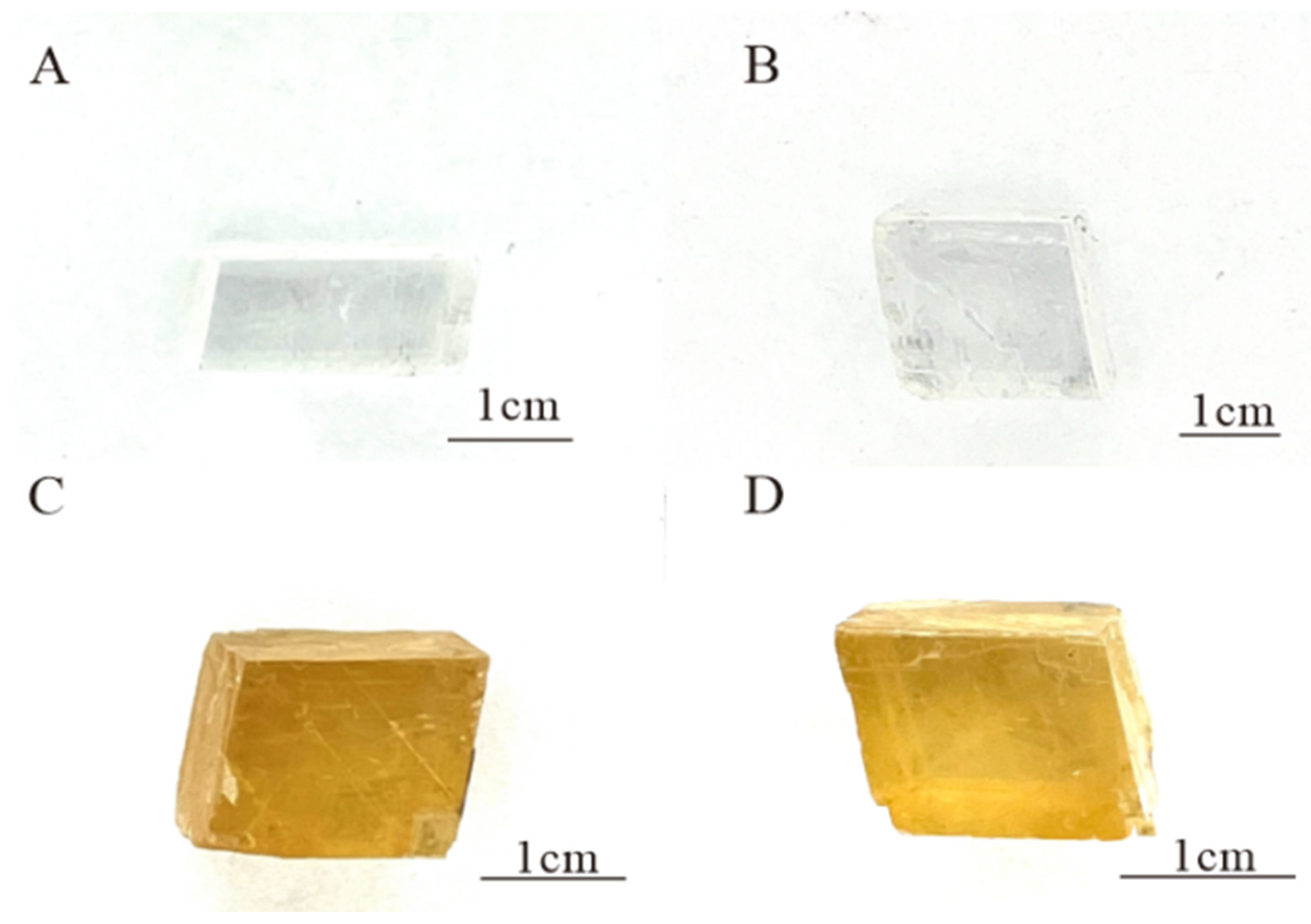

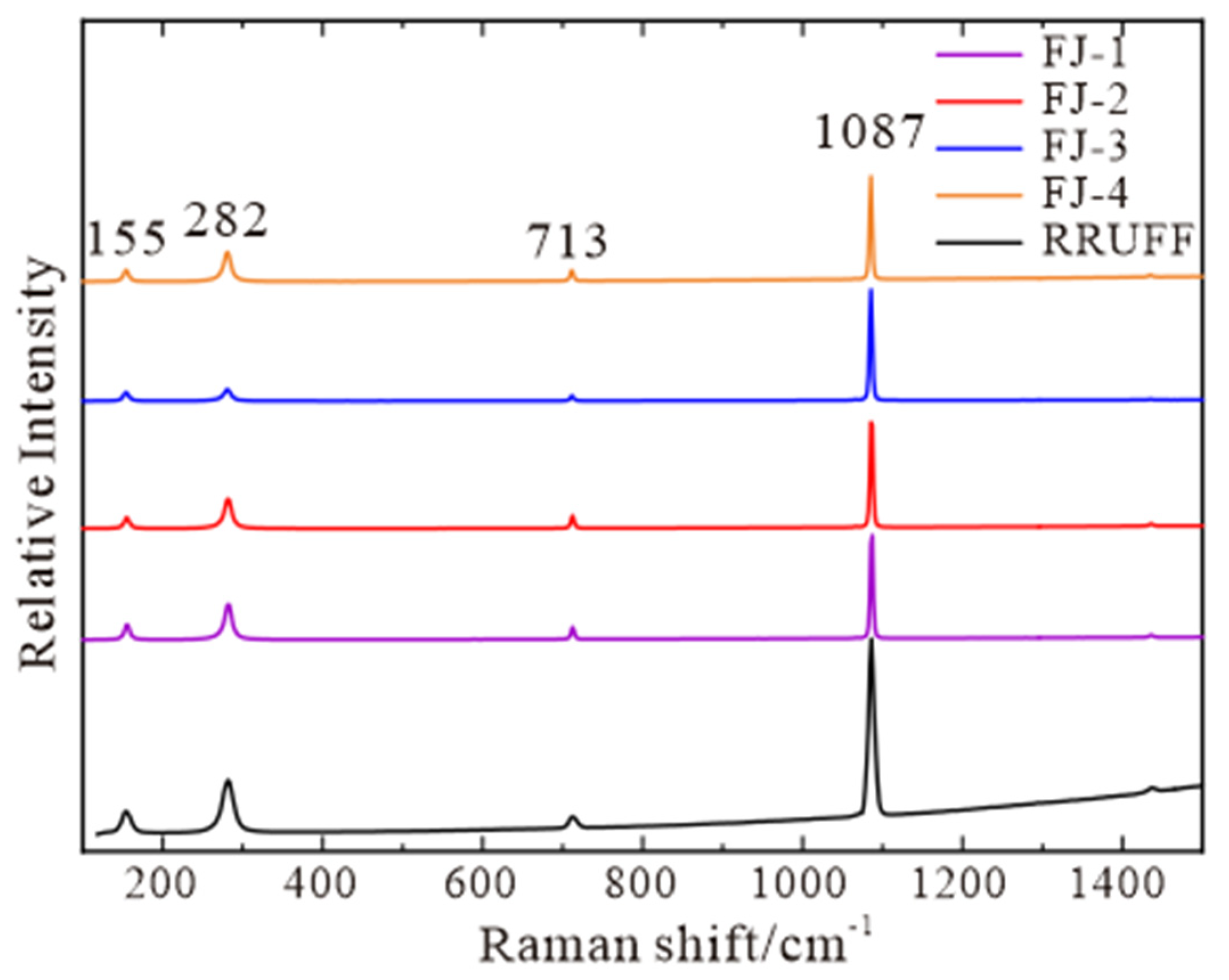
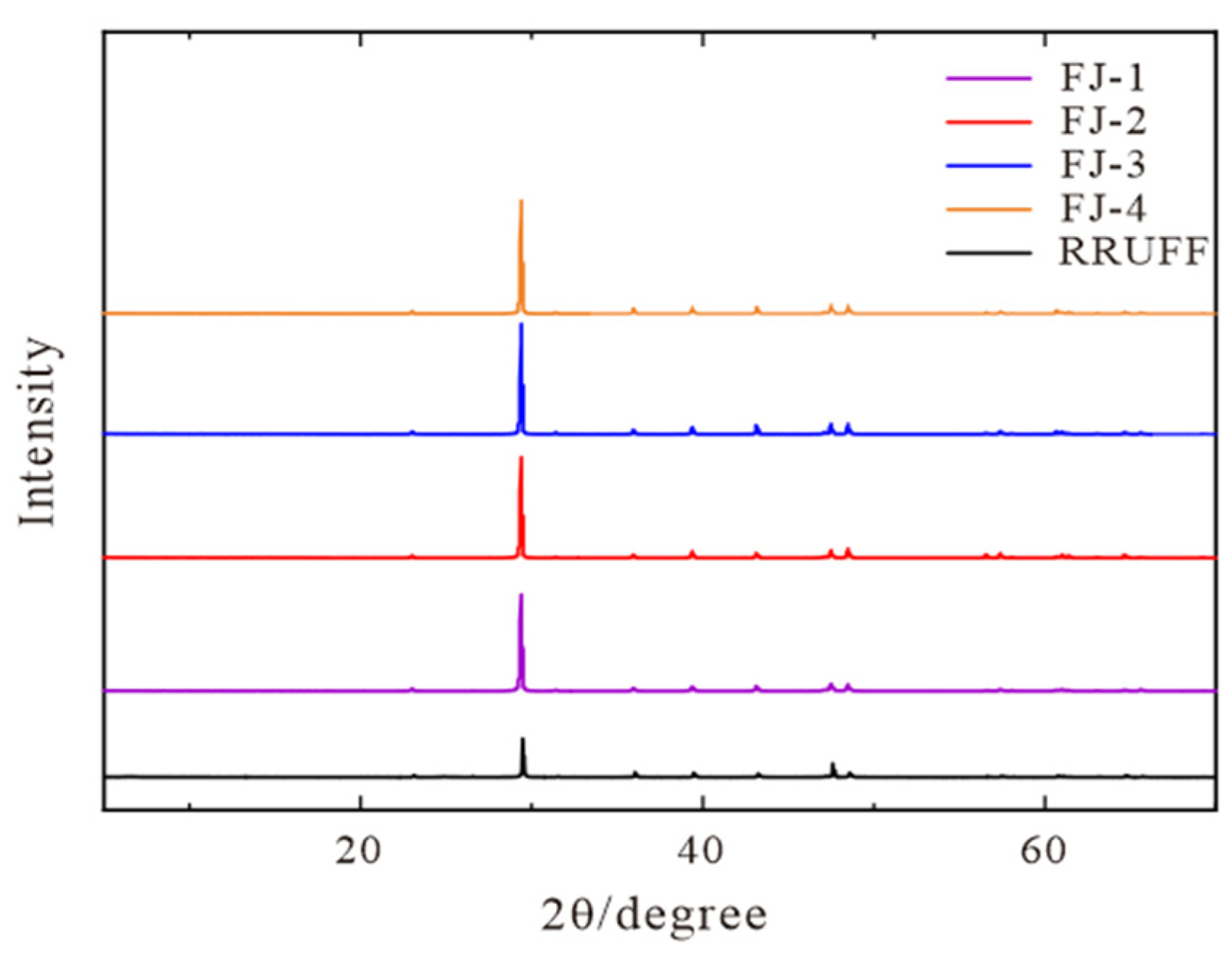

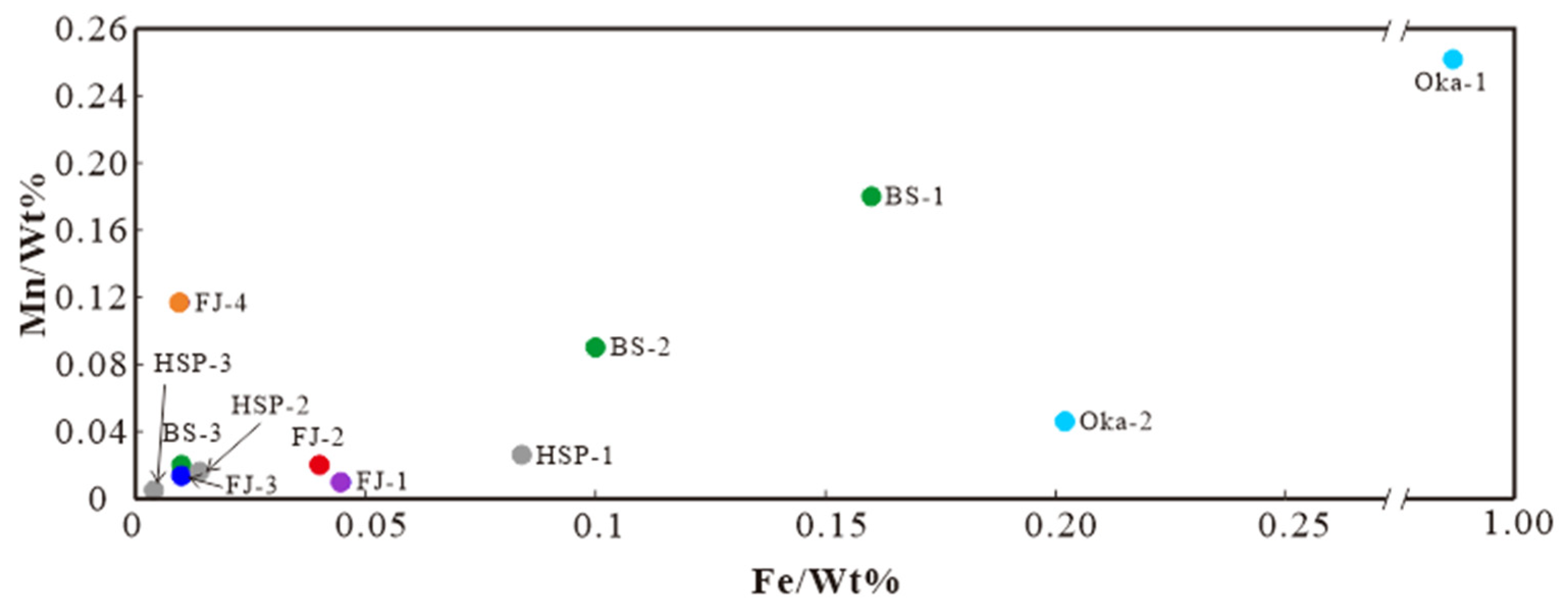
| a/Å | b/Å | c/Å | α/° | β/° | γ/° | |
|---|---|---|---|---|---|---|
| FJ-1 | 4.987 | 4.987 | 17.053 | 90.0 | 90.0 | 120.0 |
| FJ-2 | 4.988 | 4.988 | 17.055 | 90.0 | 90.0 | 120.0 |
| FJ-3 | 4.987 | 4.987 | 17.055 | 90.0 | 90.0 | 120.0 |
| FJ-4 | 4.986 | 4.986 | 17.050 | 90.0 | 90.0 | 120.0 |
| RRUFF | 4.987 | 4.987 | 17.050 | 90.0 | 90.0 | 120.0 |
| δ13CV-PDB (‰) | δ18OV-PDB (‰) | δ18OV-smow (‰) | |
|---|---|---|---|
| FJ-1 | 2.08 | −16.98 | 13.36 |
| FJ-2 | 2.22 | −17.47 | 12.85 |
| FJ-3 | 3.70 | −14.24 | 16.18 |
| FJ-4 | 3.61 | −15.61 | 14.77 |
Disclaimer/Publisher’s Note: The statements, opinions and data contained in all publications are solely those of the individual author(s) and contributor(s) and not of MDPI and/or the editor(s). MDPI and/or the editor(s) disclaim responsibility for any injury to people or property resulting from any ideas, methods, instructions or products referred to in the content. |
© 2022 by the authors. Licensee MDPI, Basel, Switzerland. This article is an open access article distributed under the terms and conditions of the Creative Commons Attribution (CC BY) license (https://creativecommons.org/licenses/by/4.0/).
Share and Cite
Zhao, Z.-Y.; Lin, Y.-T.; Zhao, Y.; Xu, B. Mineralogical Characteristics Study of Calcite from the Fujian Province, China. Crystals 2023, 13, 51. https://doi.org/10.3390/cryst13010051
Zhao Z-Y, Lin Y-T, Zhao Y, Xu B. Mineralogical Characteristics Study of Calcite from the Fujian Province, China. Crystals. 2023; 13(1):51. https://doi.org/10.3390/cryst13010051
Chicago/Turabian StyleZhao, Zhe-Yi, Yu-Tao Lin, Yi Zhao, and Bo Xu. 2023. "Mineralogical Characteristics Study of Calcite from the Fujian Province, China" Crystals 13, no. 1: 51. https://doi.org/10.3390/cryst13010051
APA StyleZhao, Z.-Y., Lin, Y.-T., Zhao, Y., & Xu, B. (2023). Mineralogical Characteristics Study of Calcite from the Fujian Province, China. Crystals, 13(1), 51. https://doi.org/10.3390/cryst13010051






